Top 10 Most Expensive Camera Lenses In The World
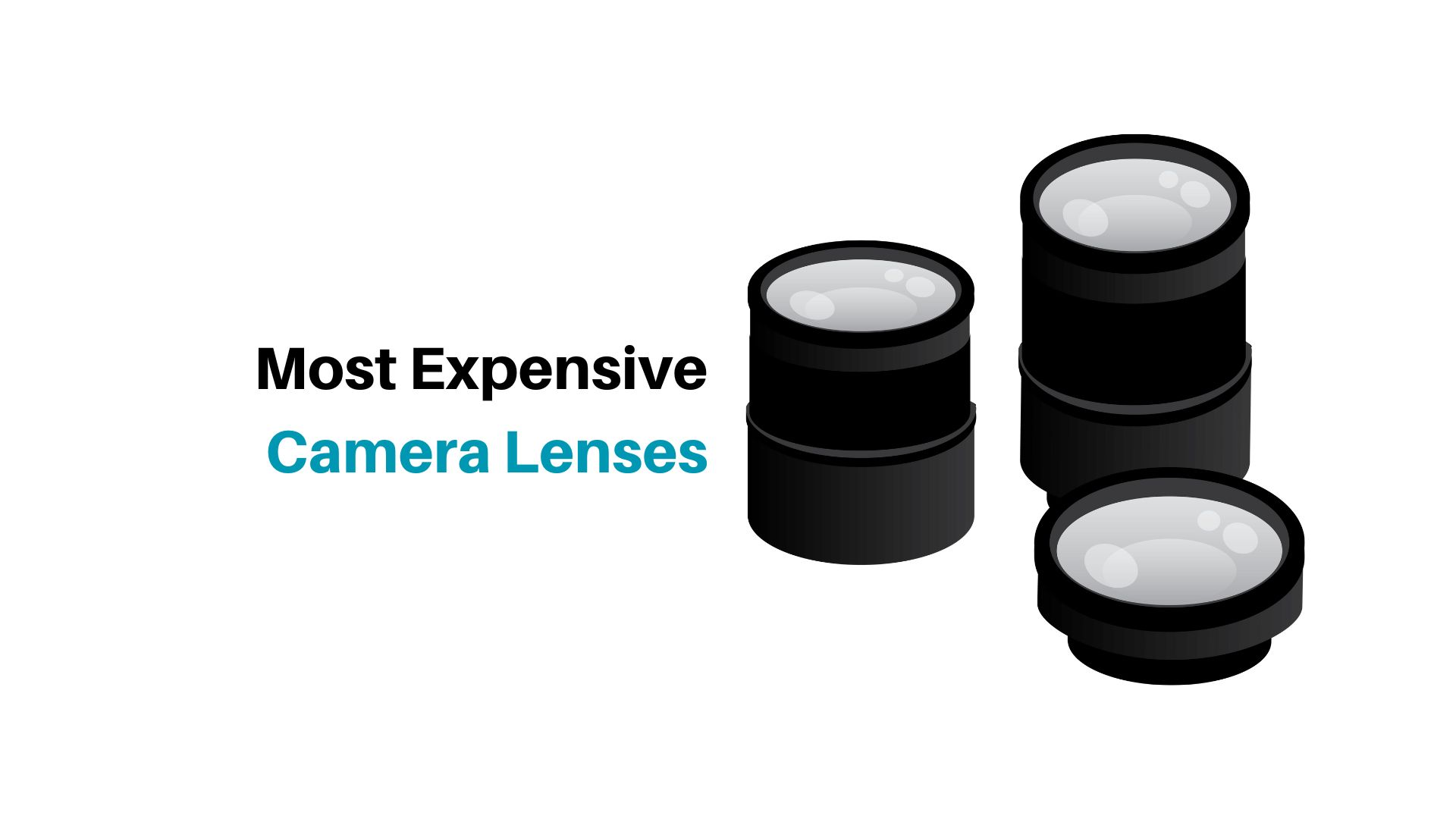
Page Contents
Most Expensive Camera Lenses – As an integral component of a camera system, camera lenses play an essential role in gathering and focusing light onto its sensor or film. They influence every element of an image's angle of view, depth of field, and overall quality; their focal length dictates this. Every type of lens – from wide-angle to telephoto – serves a different task; wide-angle lenses provide a wider field of view for landscape photography while telephoto lenses have smaller fields that make them suitable for taking portraits or wildlife images. The amount of light passing through a lens and its depth of field depends on its maximum aperture; more light can pass through with smaller apertures (f-number), while lesser amounts pass through with larger ones (f-number).
History of Camera Lens
Early 19th-century photography began alongside its history of camera lenses. Simple glass lenses, sometimes consisting of just one element, were utilized to focus light onto light-sensitive plates or films in early cameras. Photographers then experimented with increasingly intricate lens designs in the middle 1800s; among these was Joseph Petzval's Petzval lens, which featured a faster aperture and produced crisper photographs than earlier lenses.
Lens makers continuously improved their designs during the 19th and early 20th centuries, producing lenses with multiple components designed to correct for various aberrations such as distortion and chromatic aberration. Professional photographers relied upon Carl Zeiss and Schneider-Kreuznach lenses produced for high-quality images produced during these centuries; amateur photographers could also take advantage of Carl Zeiss and Schneider-Kreuznach lenses produced. When 35mm cameras and interchangeable lens systems became mainstream in photography during this period, switching lenses to achieve different focal lengths or perspectives made switching lenses easy allowing captures of diverse subjects and styles more easily than ever before.
Lens design evolved along with photography's rapid growth. Apochromatic and aspherical lenses emerged due to new materials and production methods in the mid-20th century, reducing aberrations by eliminating more. Autofocus technology and electronic cameras emerged later on and presented designers with additional challenges; electronic cameras required lenses with built-in motors for communicating, while autofocus lenses needed quick, accurate focusing mechanisms.
No longer limited to just smartphone photography, camera lenses have undergone massive evolution over the years to meet ever more detailed photographic requirements. From tiny lenses designed for smartphone cameras all the way up to giant telephoto lenses used professionally for sports and wildlife photography – there are now an amazing variety of camera lenses on the market today. Thanks to cutting-edge optics and computer-aided design tools, current lens designs continue to push beyond what was once thought feasible; as manufacturers and photographers work to capture every scene with greater clarity and detail than before – camera lenses have undergone a constant transformation over time.
Types of Camera Lens
There are countless types of camera lenses on the market, each offering distinct qualities and applications.
- Regular Lenses: Also referred to as standard lenses, these lenses feature an approximate full-frame camera focal length of 50mm and provide realistic photography similar to what the human eye perceives. Regular lenses can make excellent daily photographs.
- Broad-Angle Lenses: Broad-angle lenses feature a wider field of view and shorter focal length (usually under 35mm on full-frame cameras), making them suitable for real estate, architectural and landscape photography. They're often employed when photographing real estate transactions or landscape scenes.
- Telephoto Lenses: Telephoto lenses are great for shooting sports, animals, and portraits since their longer focal length (usually over 70mm on full-frame cameras) allows you to capture larger subjects against distant backgrounds more effectively. Their limited field of view helps close in on subjects quickly while compressing the distance between the subject and the backdrop.
- Zoom Lenses: With their adjustable focal lengths and interchangeable lens elements, zoom lenses allow photographers to easily change the frame without moving. Zooms are widely used for photojournalism, travel photography, and events photography.
- Prime Lenses: Prime lenses boast superior image quality over zoom lenses due to their fixed focal length. Primes are often utilized in low-light, street, and portrait photography.
- Macro Lenses: Macro lenses are great tools for taking close-up images of small subjects like flowers, insects, and textures thanks to their close focusing distance and high magnification ratio.
- Fisheye Lenses: Fisheye lenses have an extremely wide field of view, producing circular, distorted images. They're commonly employed in experimental and artistic photography.
- Tilt-Shift Glasses: Tilt-Shift glasses allow users to tilt the lens forwards or backward as well as move it upwards or downwards and right or left, making it possible to regulate the depth of field and rectify perspective distortion, often employed for building photography.
Uses of Camera Lens
Camera lenses have many uses in photography and cinematography, including
- Portrait photographers typically turn to larger focal length lenses like 85mm or 135mm primes for portrait photography, often creating a pleasing bokeh effect and narrow depth of focus – perfect for isolating subjects from their background while giving images a more pleasing look.
- Landscape photographers commonly employ wide-angle lenses with focal lengths of 10-24mm for landscape photography, as they provide a broad field of view that makes it ideal for photographing open spaces, urban scenes, and natural environments.
- Wildlife photography frequently relies on lenses with focal lengths of 300mm or greater for wildlife photography, enabling photographers to capture detailed shots of distant animals without endangering or distressing them. With these lenses in place, it becomes possible to take photographs that capture precise images without injuring or upsetting them in any way.
- Sports photography requires lenses with fast focusing and wide apertures, like 70-200mm or 300mm prime lenses; that provide excellent images even in low lighting. Such lenses can quickly freeze moving subjects for stunning photos.
- Macro lenses equipped with tight focusing distance and a high magnification ratio are used to capture close-up images of insects; flowers, and textures at close range.
- Lenses with 35mm or 50mm focal lengths are often utilized when shooting street photography in urban environments. These lenses allow photographers to capture natural moments without drawing too much attention to themselves as photographers.
- Filmmakers looking for that cinematic feel typically employ lenses with smooth focus and aperture adjustment capabilities such as cine lenses. Cine lenses may be used to achieve particular looks or effects and come in various aspect ratios.
Its Significance
Camera lenses are an integral component of camera systems and play a critical role in setting image standards and characteristics. Camera lenses play an integral part in many important situations where their importance can be seen:
- The focal length of lenses determines both the angle of view and size of subjects in photographs, making a wide-angle lens an excellent choice for landscape and building photography with a larger field of vision and shorter focal length. Conversely, telephoto lenses have longer focal lengths with narrower ranges, making them better suited for portraiture or animal shooting. By changing lenses when necessary photographers can adapt quickly to various shooting situations and achieve diverse images.
- Depth of field, or the range of distances that are sharply in focus, is controlled by the aperture of a lens. Lenses with larger apertures (smaller f-numbers) produce a narrower depth of focus for photographers who wish to isolate subjects against blurrier backgrounds; similarly; a lens with narrower apertures can produce clear, crisp images from front to back using narrower f-numbers (narrower apertures).
- Lens quality can have a dramatic impact on the quality of photos taken with it, creating sharp, finely detailed photos with little distortion, aberration, or color fringing. Lens coatings may help reduce glare while increasing contrast for improved color rendition.
- Photographers can be more versatile and creative with their work by changing lenses to obtain various focal lengths; apertures and effects. Photographers also often experiment with various approaches and methods in order to capture a variety of themes and emotions through photography.
- Lens technology has advanced tremendously over time, enabling photographers to easily take precise; artistic photographs. New lens designs and materials have also provided higher-quality optics and enhanced low-light performance.
No one can overstate the significance of camera lenses in our world today; they are critical tools in accurately and creatively documenting what lies around us. Camera lenses offer unlimited opportunities for artistic vision and creative expression as technology develops and new lens designs are created.
The Popularity of Camera Lens
Camera lenses are indispensable parts of a camera system, as their use directly impacts image quality and adaptability.
One factor contributing to camera lenses' popularity is their variety. From wide-angle to telephoto lenses, each type offers different focal lengths and should be used for specific tasks; wide-angles work well for photographing nature and architecture while telephoto lenses excel in shooting action and animals. As changing lenses allow photographers to adapt quickly to changing conditions or topics.
Lenses have also become incredibly popular because of their ability to produce different effects and styles; giving photographers the ability to achieve different depths of field and create shallow focus effects in images. Furthermore; coated lenses may offer different color renderings or contrast levels which enable photographers to achieve particular looks or styles for their pictures.
Technology innovations can also be attributed to the rising popularity of camera lenses. New lens designs and materials have enabled photographers to capture sharper; more detailed pictures. Thanks to autofocus technology, photographers may now focus on objects quickly and precisely; while handheld photography or low-light photography has become easier thanks to image stabilization.
The growth and accessibility of photography gear have contributed to an explosion of camera lens popularity. Thanks to digital photography, taking and sharing high-quality photos has never been simpler; third-party lenses give photographers more options at reasonable prices when exploring various lens designs and styles.
Photography has long been an enjoyable pastime and career option. Many still find the ability to take and share images of the world fascinating; camera lenses play a critical role here by providing the clarity, accuracy, and creativity needed for great photographs.
Why Camera Lenses Are Expensive?
Camera lenses can be expensive for several reasons, including these:
- High-quality lenses are constructed using costly components like particular types of glass designed to minimize optical aberrations like color fringing, distortion, and other flaws. Production costs for high-quality lenses tend to be more extensive due to a more complex manufacturing process.
- New lens technologies are constantly being researched with generous funding from camera makers. This includes developing novel glass varieties, coatings, and optical designs – the cost of which often end up being passed onto users through higher costs for cutting-edge lenses.
- Precision manufacturing processes such as grinding, polishing, and coating the glass components required for creating camera lenses must adhere to stringent specifications in order to guarantee they operate effectively and meet professional photographers' high standards. Accuracy must also be ensured in terms of functioning as intended and in meeting professional photographers' high expectations for quality photos.
- Due to limited production runs of certain lenses, their prices may increase accordingly. This could be caused by using harder-than-average materials or being targeted toward niche markets.
- Some camera manufacturers are known for producing superior lenses. Even when offered at lower prices from less renowned makers, customers might still prefer investing in one from a renowned brand.
- Some lenses feature extras such as image stabilization, quick focusing, and weather sealing – features that add cost but may be necessary for specific types of photography.
- The price of camera lenses can be determined by supply and demand forces; those in high demand may pay more, while supplies remain scarce or increase over time, further increasing acquisition costs.
Lenses have an enormous effect on the quality of images captured, prompting many photographers to invest in high-grade lenses.
Top 10 Most Expensive Camera Lenses In The World
- Leica Apo-Telyt-R 1:5.6/1600mm – (Worth USD 2 Million)
- Nikkor 6mm f/2.8 Fisheye Lens – (Worth USD 160,000)
- Carl Zeiss 50mm Planar f/0.7 Lens – (Worth USD 140,000+)
- Zeiss Apo Sonnar 1700mm f/4 – (Worth USD 100,000+)
- Canon EF 1200mm f/5.6 L Lens – (Worth USD 90,000)
- Nikon 1200-1700mm f/5.6-8.0 Lens – (Worth USD 60,000)
- Canon 5200mm f/14 Lens – (Worth USD 45,000)
- Sigma APO 200-500mm f/2.8 with 2x Teleconverter – (Worth USD 26,000)
- Nikon AF-S Nikkor 800mm f/5.6E FL ED VR w/1.25 Teleconverter – (Worth USD 16,300)
- Horseman 23mm f/5.6 HR Digaron-S Lens Unit – (Worth USD 15,620)
#1. Leica Apo-Telyt-R 1:5.6/1600mm – (Worth USD 2 Million)
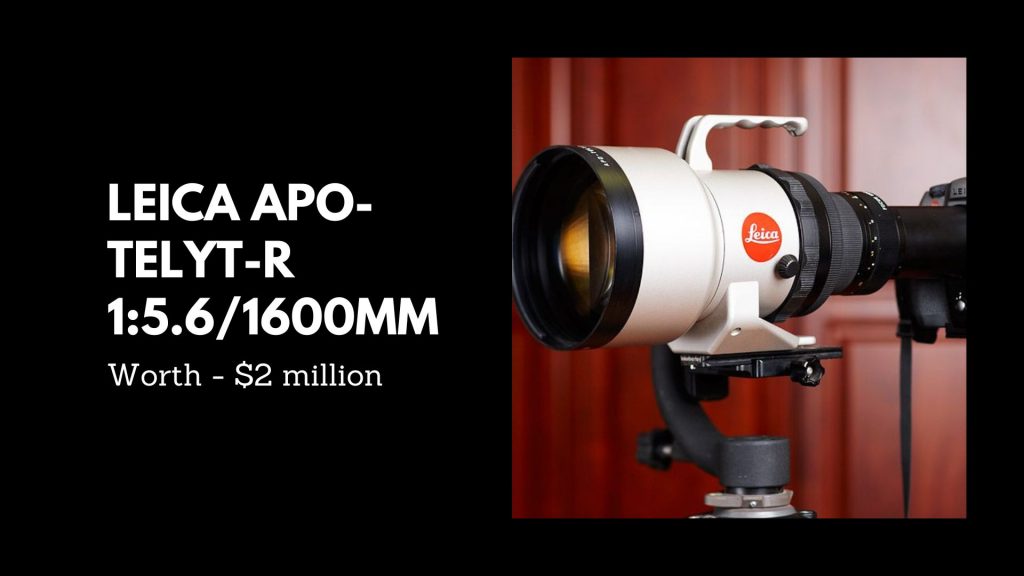
Leica APO-Telyt-R 1:5.6/1600mm holds the unenviable distinction of being the world's most expensive camera lenses ever manufactured for general public consumption; unfortunately, only two units were ever sold worldwide. Leica's Solms factory now displays a functional prototype; while photographer Saud bin Muhammed Al Thani of Qarati (Syria) requested another version made specifically for him by a photographer. Prince Alwaleed previously purchased one of only two copies for over $2 Million – making it one of the most costly camera lenses ever sold in photography history.
This lens measures around 1.2m long (1.55m with the lens hood attached), has a maximum barrel diameter of 42cm, is compatible with Leica R-series manual focus SLR cameras, weighs at least 60kg, and only covers 1.5 degrees diagonal angle of view with 1600mm focal length. Leica offers two APO teleconverters that should make this lens compatible: one 1.4x and two 2x APO teleconverters for optical systems that measure 1:8/2,240mm and 1:11/1,200mm respectively. Sheik Al-Thani likely purchased this lens to photograph animals.
#2. Nikkor 6mm f/2.8 Fisheye Lens – (Worth USD 160,000)
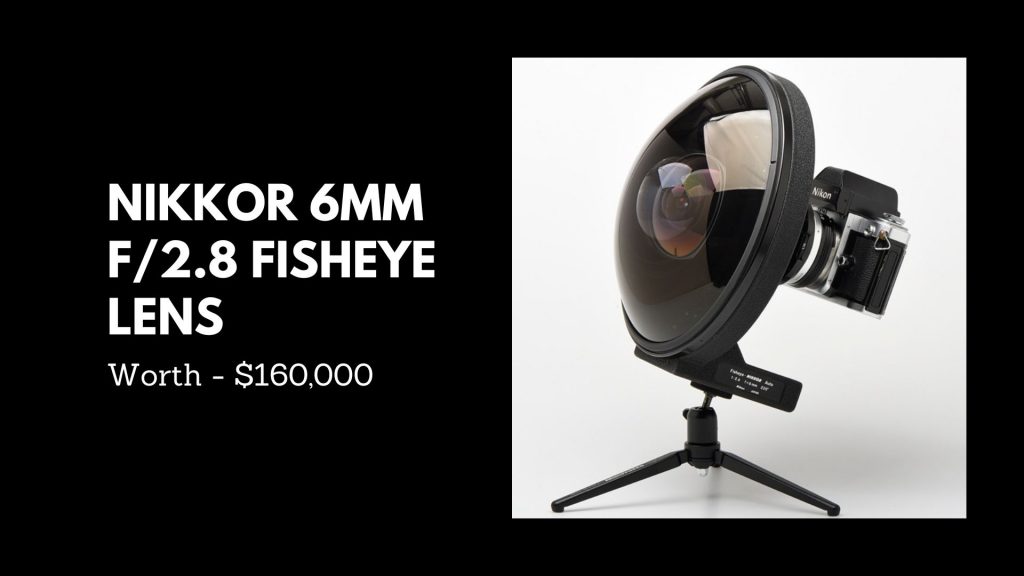
London's costliest camera lens is the Nikkor 6mm f/2.8 fisheye lens, boasting a 220-degree field of view and the unique ability to capture its own image. This lens was originally unveiled at the 1970 Photokina trade show in Cologne; Germany; and was one of only four lenses available at the time that could cover a 24x36mm picture area. Gray Levett from Westminster; London; discovered this 5.2kg lens during his travels; measuring an impressive 171mm in length and 236mm in diameter. It stands second in the most expensive camera lenses in the world list.
Nikkor 6mm f/2.8 fisheye lens; stands out among its large and innovative peers; with its unparalleled wide-angle perspective; features 12 lens systems divided into 9 groups and six built-in white balance filters; designed with purpose; and precision. Although it carries a hefty price tag of $160,000 and is only produced upon demand; its exceptional features quickly made it an invaluable choice among professionals as well as enthusiasts. Limited production was intended to meet demand by scientists or commercial entities; only a limited number have ever been produced so far.
#3. Carl Zeiss 50mm Planar f/0.7 Lens – (Worth USD 140,000+)
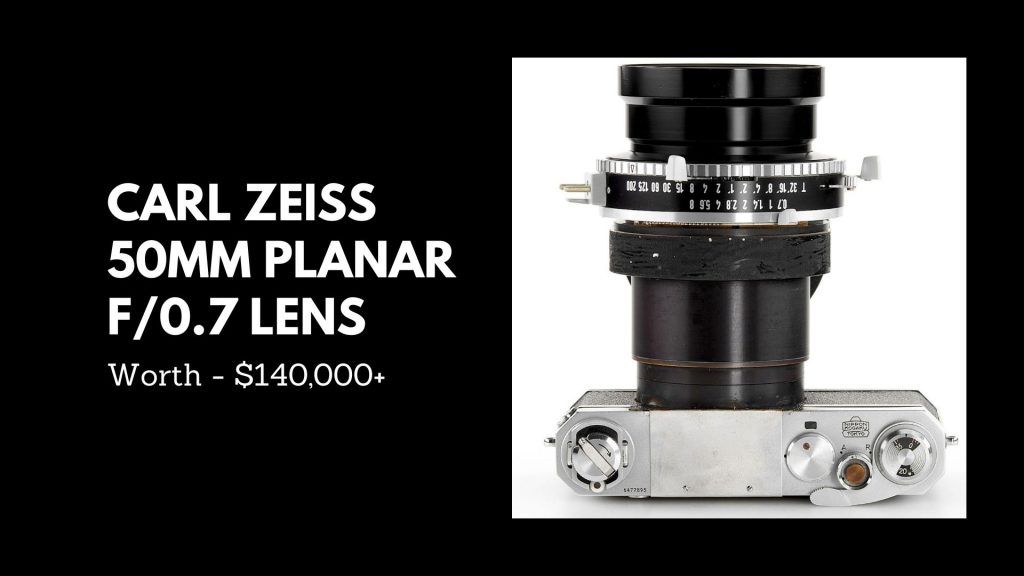
If the Nikkor Z 58mm F0.95 S Noct lens from Nikon is impressive, consider taking note of NASA's use of an extremely rare Zeiss Planar 50mm F0.7 lens from 1966 for lunar missions. NASA used this Zeiss lens to capture images from the far side of the moon using it during Apollo missions. There were only 10 lenses ever produced, of which six were given to NASA and are being auctioned off by Leitz Photographica now. Naturally, their quick debut will come at a premium cost.
Although the auction does not officially commence until June 12, the highest bid has already reached EUR55,000 (approximately $67,000), which is EUR5,000 more than its starting price. According to organizers, an expected hammer price of about EUR120,000 might also be achieved. Carl Zeiss is known for its super-large aperture lenses, yet not all are effective. One lens that stands out is this unique Planar 50mm f/0.7 lens; NASA placed an order with them back in 1966 so as to explore the moon's shadow side.
#4. Zeiss Apo Sonnar 1700mm f/4 – (Worth USD 100,000+)
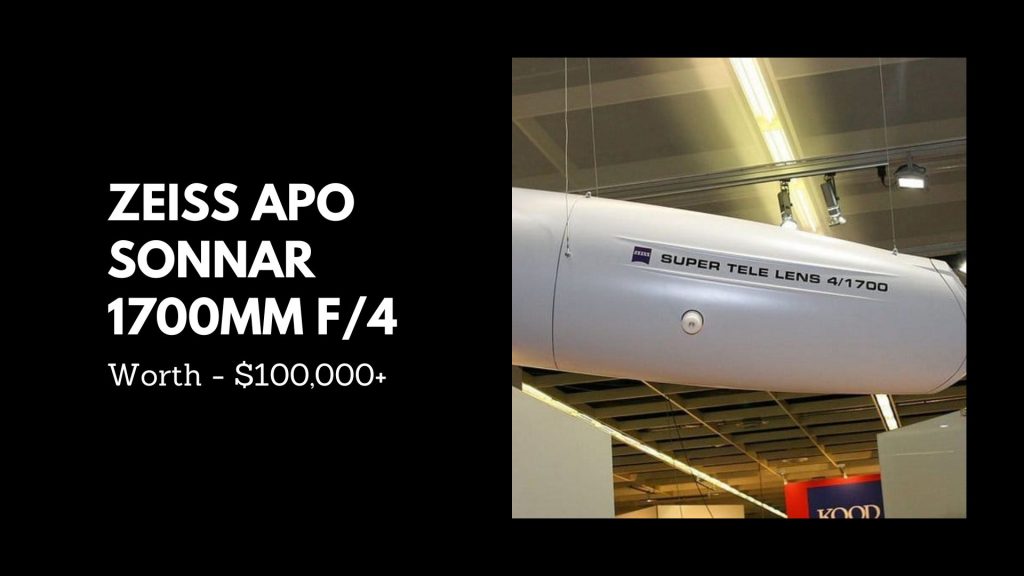
Carl Zeiss created an extraordinary lens, the Zeiss APO Sonnar 1700mm f/4, specifically tailored to meet the photography needs of an athlete from Qatar who enjoys taking photographs of storks. If you have enough money, Carl Zeiss could even custom design something “one-of-a-kind”. Cost information has never been made public, but its enormous size, cutting-edge technology, and complex lens composition (15 components in 13 groups) would require incredible luck to afford it at such a magnitude of money. Carl Zeiss invented an unprecedented lens: the ZEISS Apo Sonnar T* 4/1700 was specially made for an ambitious customer who enjoys long-distance wildlife photography.
In order to achieve optimal image quality, the customer selected a Hasselblad 203FE 6x6cm medium format camera and ZEISS lenses as the ideal combination for his specific demands. In collaboration with Zeiss, an innovative focus servo control system similar to what can be found on astronomical telescopes was also developed; optical glass manufacture was put through rigorous trials as this project included a 1700mm focal length and an f/4 aperture; this unique design also involved casting delicate, rare types of glass never before seen on the such scale!
#5. Canon EF 1200mm f/5.6 L Lens – (Worth USD 90,000)
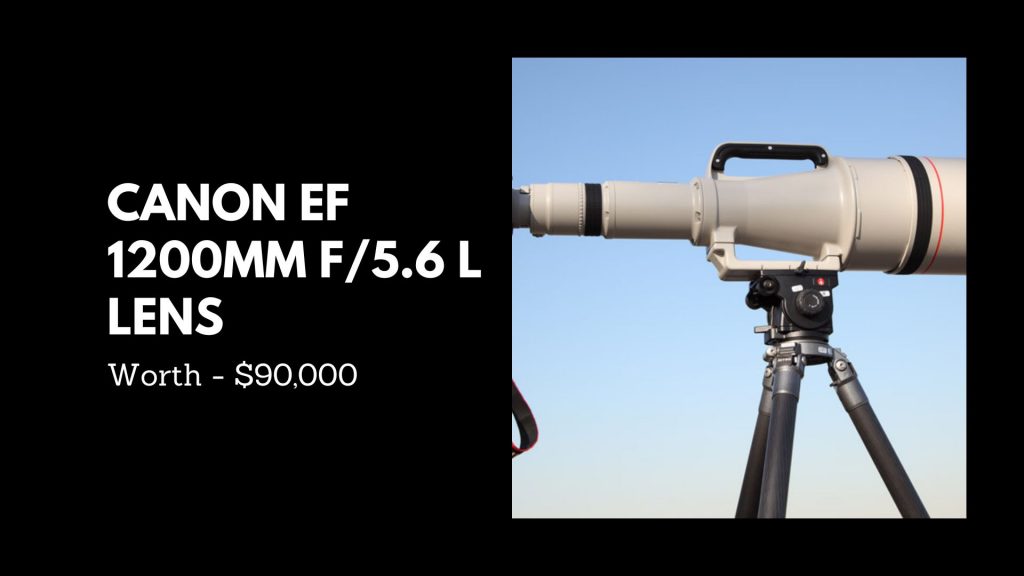
Sooner rather than later, telephoto lenses will outnumber camera lenses in terms of complexity, speed, and size. Unsurprisingly, our Canon EF 600mm f/4L IS USM stands as one of the first on this list. At its initial debut, Canon's EF 1200mm f/5.6L USM lens system was the largest lens available based on both focal length and maximum aperture. Crafting such an immense lens took considerable time and resources – including special coating materials – before finally becoming a reality. 13 lenses were divided into 10 groups using an eight-blade aperture system weighing 16.5kg and measuring 836x228mm to accommodate 48mm filters, using USM ultrasonic motor technology for power.
Canon's EF 1200mm f/5.6L USM lens was specifically created for large and broader applications, costing a whopping $90,000. As one of the world's most expensive lenses ever produced, this piece was specially commissioned for use at Los Angeles Summer Olympics in 1984. Canon originally created five lenses specifically tailored for photojournalists during the Olympics and afterward delivered them back to Canon's corporate office in Japan for production in smaller batches; each lens requires considerably skilled hand craftsmanship requiring many months or years for completion, leading to severe shortages and sky-rocketing prices.
#6. Nikon 1200-1700mm f/5.6-8.0 Lens – (Worth USD 60,000)
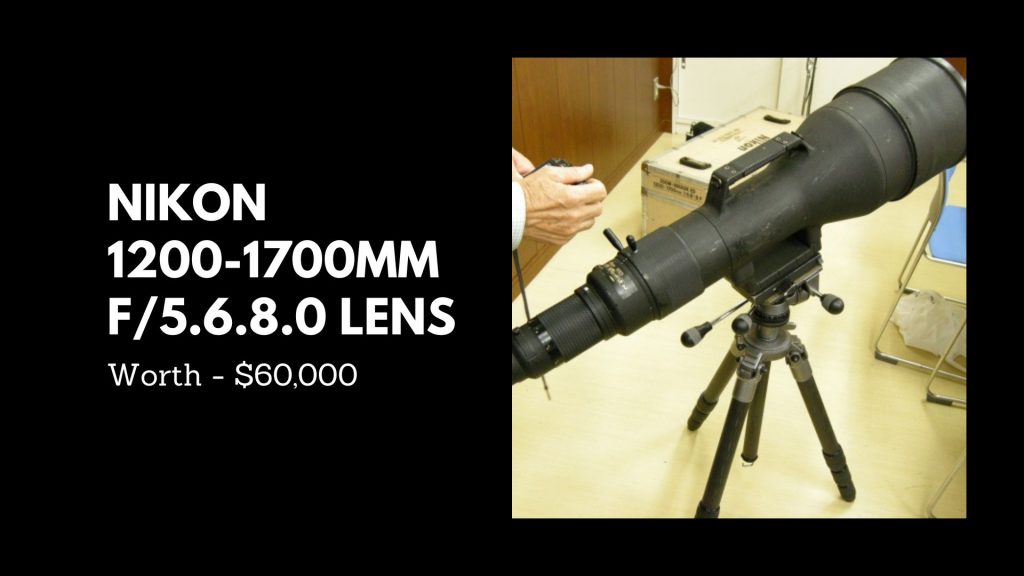
With 18 elements arranged into 13 groups and an approximate close focusing distance of 10 meters; this lens weighs more than 16 kg. Another standout feature of the product; is its two-piece construction; one half remains fixed even when turning the camera to correct horizontal/vertical alignment issues. F/5.6-8P IF-ED 1200-1700mm without internal focus motor. According to its manufacturers; the 1200-1700mm f/5.6-8.0 lens was created specifically for sports and wildlife photography. An example of an arrangement for this lens can be seen here in which two halves of its barrel are linked mechanically and electrically for a vertical/horizontal rotational mechanism.
A focus group movement is translated from focus ring rotation. A prototype was completed in February 1990. Assembly, adjustment, lens processing; working with metallic components, and optical design were completed smoothly; as trial production proceeded efficiently. Initial tests of this lens took place in Koshien Stadium where high school baseball competitions took place that year; with comprehensive photographic tests then taking place to complete its creation as the highest-precision Nikon lens at that time.
#7. Canon 5200mm f/14 Lens – (Worth USD 45,000)
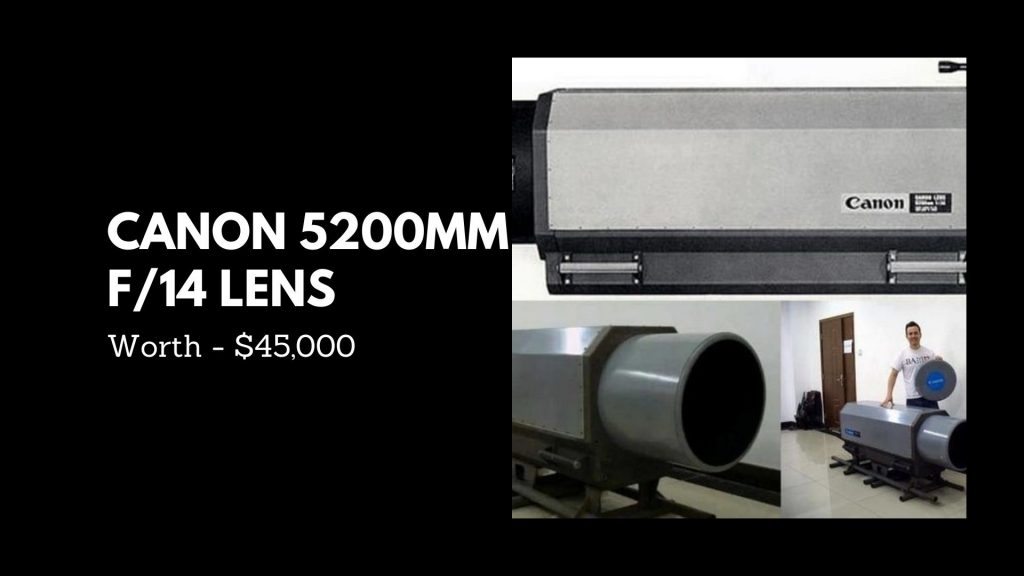
The Canon 5200mm 1:14 Mirror Lens is a remarkable achievement in the world of SLR lenses, being the largest of its kind. It boasts a focus capacity of up to 32 miles and a minimum focusing distance of 120 meters. Transporting the lens is relatively easy, despite its hefty 100kg weight when unsupported. Full-frame DSLRs offer a focal length of 5200mm, while APS-C DSLRs offer 8320mm. Due to its rarity – only three of these lenses have ever been produced – an auction for the lens generated quite a stir on eBay.
This particular lens was crafted in Japan, purchased by a Chinese company, and subsequently put up for sale after hardly any usage. The optics appear to be in excellent condition, leading the team of optical specialists to consider devising a custom SLR/DSLR/EF mount. This enormous lens may be better suited for astronomical purposes, requiring the strength of two people to lift it. It is best mounted on an SUV or a modified vehicle, and in order to achieve its full magnification potential, a motorized or large gear-geared support head is necessary.
#8. Sigma APO 200-500mm f/2.8 with 2x Teleconverter – (Worth USD 26,000)
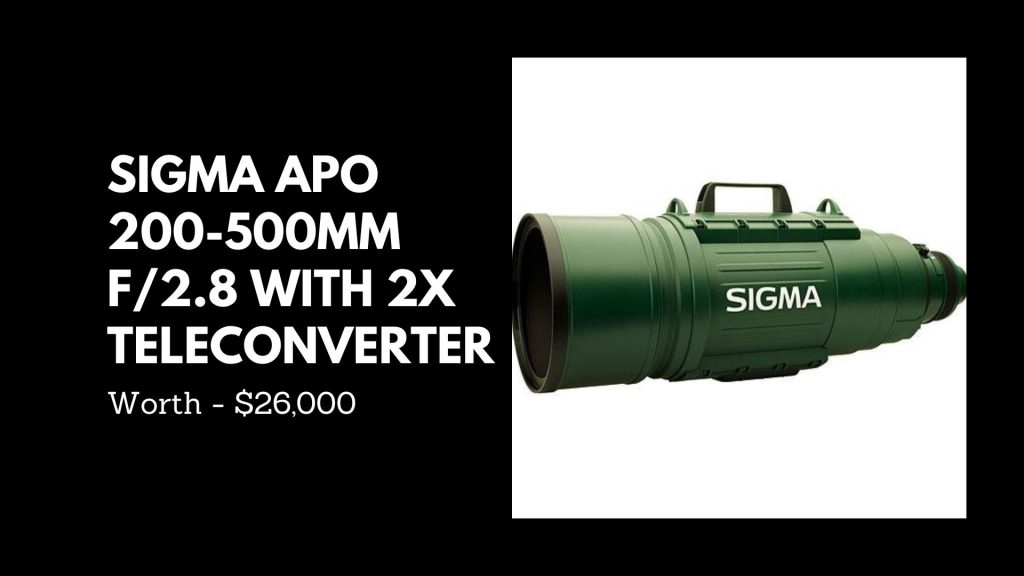
Due to its emerald hue and immense size, the Sigma APO 200-500mm lens could easily be described as The Incredible Hulk of lenses. Just like his comic counterpart; this beast moves swiftly while smashing both your finances and aspirations simultaneously.
This lens is known for being an apochromatic ultra-telephoto zoom lens featuring an unprecedented maximum aperture of f/2.8 at 500mm focal length – an engineering feat no other lens could match! This technological feat makes this technical endeavor truly impressive. The lens features an internal battery-powered motor that operates an LCD panel to display the current focus distance and magnification.
Wildlife and sports photographers will find these lenses particularly appealing; Canon, Nikon, and Sigma cameras can all use one. After more than ten years since its debut, Sigma's APO 200-500mm lens remains one of the most expensive available through standard channels and remains somewhat of an enigma to most buyers. Even with endless funds, most would probably find the lens more intriguing than necessary, given its spectacular high ISO capabilities of modern cameras.
While its impressive specs outdo all others on paper; in practice it may prove challenging to operate due to its sheer size and electronic focus feature – both of which stand out dramatically against its competition.
#9. Nikon AF-S Nikkor 800mm f/5.6E FL ED VR w/1.25 Teleconverter – (Worth USD 16,300)
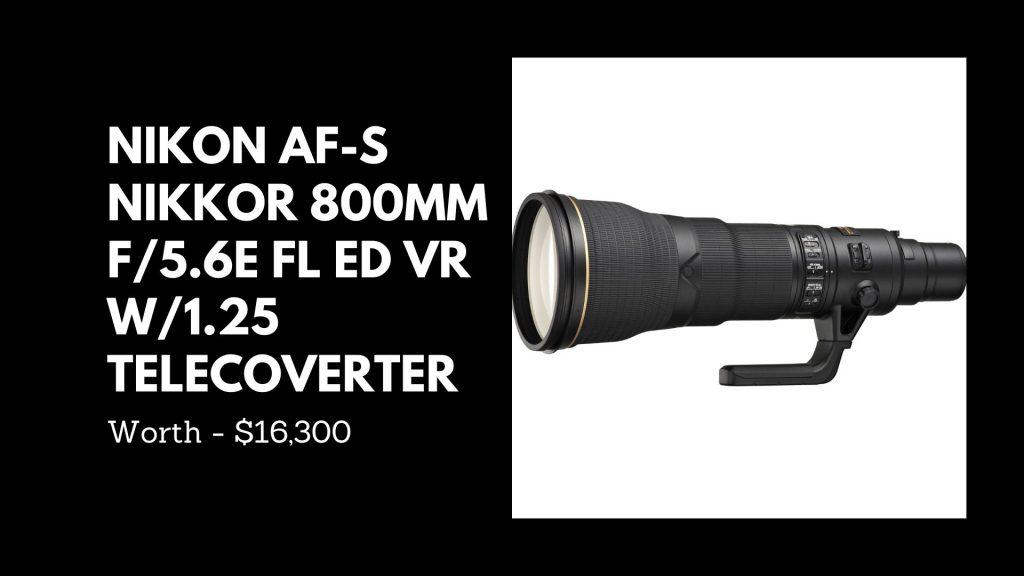
As long as it took to arrive is an understatement. Nikon had not modified their 800mm f/5.6 ED-IF manual focus lens in over 25 years. Nearly 10 years ago they made announcements regarding an autofocus version – finally an 800mm lens had come along at last! Nikon delivered without question.
Their Nikkor 800mm marks an important advance, as it marks their first lens ever designed with fluorite elements outside of microscopy and medicine applications. Nikon is breaking with tradition with this telephoto lens by employing an electromagnetic diaphragm mechanism for accurate electrical control, offering users greater precision when it comes to image capture. This innovative solution allows photographers to achieve accurate results across different exposures while shooting rapidly in autofocus mode.
Thanks to a narrower barrel and favorite elements, the 800mm lens is lighter, more stable, and user-friendly than either its 600mm or 400mm predecessors. Utilizing autofocus is fast, accurate, and straightforward – well worth waiting for.
#10.Horseman 23mm f/5.6 HR Digaron-S Lens Unit – (Worth USD 15,620)
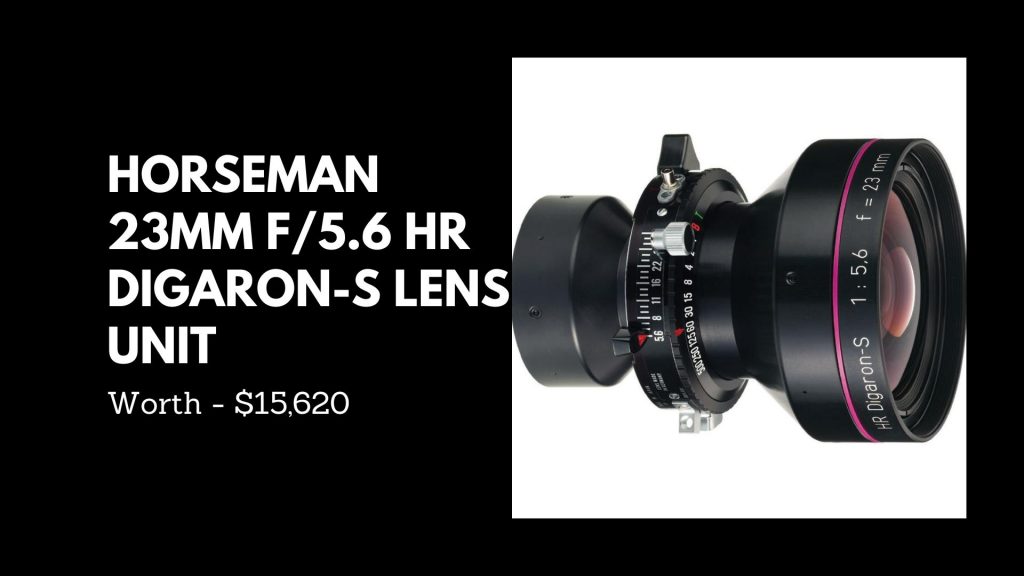
Komamura Corporation was once best known for their lightweight 6×9 and large format 4×5 field and technical cameras; which were lauded by photographers for their ability to handle larger format film photography. However, in recent years, the company has become equally recognized for its specialist digital solutions.
The Horseman VCC Pro handheld view camera is a popular choice among users who need to stitch images and control tilt, swing, shift, fall and rise motions with ease. It is compatible with Canon and Nikon SLRs. The Horseman Axella SX view camera is another one that's compatible with backs from Canon, Nikon, and Fujifilm (X and GFX), as well as Phase One and Hasselblad cameras.
For users who need full control over front/rear movement as well as vertical/horizontal stitching to produce high-resolution images, the Horseman LD Pro was specifically created for use with Hasselblad, Mamiya, and Phase One digital back.
However, it's important to note that because large format cameras use advanced technologies, super wide-angle lenses are somewhat limited in availability. The Horseman 23/5.6 Digaron-S is currently one of the broadest medium and large format lenses obtainable. It comes equipped with an exceptional focusing mechanism; consisting of standard Copal #0 shutters instead.
Bottom Line
Every camera system needs lenses, which play an integral part in creating high-quality photographs. There are various kinds of lenses on the market each with unique qualities and applications. Even though camera lenses can be expensive, serious photographers often consider them an invaluable investment for creating the highest-quality images possible. High-quality lenses require expensive materials and complex production processes – which adds cost.
Professional photographers require specific features from their lenses. When selecting one for use in photography or art photography, the type of lens chosen depends on both subject matter and artistic vision. Becoming aware of all available lenses will help you select one with appropriate features for yourself.
FAQ.
Four factors such as resolution, lens aperture, focal length/zoom range, lens quality, sensor sensitivity and camera software all influence its composition and quality.
One of the key components of any camera is its viewfinder. This rectangular component on the back allows you to view and frame your subject by providing instantaneous framing information such as shutter speed, aperture size and ISO levels before taking photos. Some viewfinders even feature full digital information displays like shutter speed settings before snapping shots!
In most cases, using a superior lens compared to what comes standard on most cameras provides a noticeable improvement in image quality. While sensors play an integral part in how a camera processes images, lenses play the greatest role when it comes to the technical quality of images.
Due to its outstanding optical qualities and scratch resistance, glass is the material most often employed when making lens elements for camera cameras. Other materials used may include germanium- and meteoritic glass as well as quartz glass, fluorite crystals and acrylic (Plexiglass).

Aditi is an Industry Analyst at Enterprise Apps Today and specializes in statistical analysis, survey research and content writing services. She currently writes articles related to the "most expensive" category.